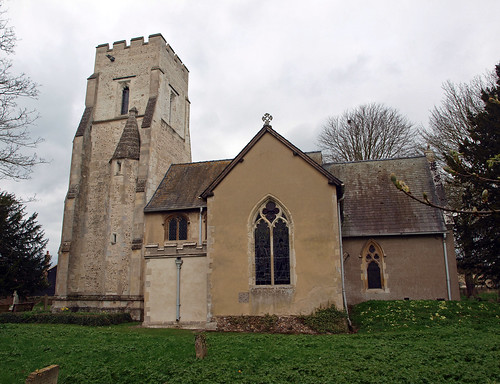Externally it's rather nice and the location is good too.
ST MARGARET. Built of clunch. W tower, plastered, Perp. Nave with two-bay arcade of octagonal piers and double-chamfered arches - i.e. C14. Of the same design the arches from the aisles into the transepts. No chancel arch. The chancel too much re-done to be of value. The transepts earlier than the aisles. In the S transept a lancet window and some C13 wall painting of red scrolls. The N transept E window nook-shafted inside. - FONT. Square, on five circular supports. Octagonal bowl with, in the diagonals, two volutes meeting at the angles of the square below; C13. - STAINED GLASS. Chancel E and S transept S window 1854 and 1855, and characteristic of the date. - MONUMENTS mostly to members of the Pemberton family: Francis d. 1809 and Mrs Anne d. 1815, both by Rossi, simple designs, one with a sarcophagus, the other with an urn. William d. 1828, by the younger Westmacott, just a tablet without much enrichment. - Christopher d. 1850, by Physick, with Charity and Justice, small relief figures l. and r. of the inscription. - Christopher d. 1870 (as a reporter at the battle of Sedan), by Noble, with a standing allegorical female. - Mrs Montagu d. 1871, by Boehm, also with a female figure, rising to heaven. - William Ward d. 1900, brass repoussé, a fine period piece of the Art Nouveau - rare in churches. - In the churchyard MAUSOLEUM in an Antique style, 1922 by Sir Ambrose Poynter.
NEWTON. It is recorded that one summer’s day in 1746 a fire here burnt down most of the village and roasted the apples as they hung on the trees. Today it has a few cottages at the cross roads, a pleasant village hall and handsome farmhouses, a great house in Georgian style, leafy lanes, and green pastures.
Great chestnuts spread themselves against the 14th century tower of the little cross-shaped church. Here is something from four of our building centuries, a fine font from the 12th, transept arches from the 13th, a nave arcade of the 14th, and a clerestory of the 15th, when the old timbers were set in the roof. Perhaps the best thing of all is the graceful tower arch, with continuous moulding.
Here are two memorials of the last great wars in Europe. One is to Christopher Peach Pemberton, who witnessed the most terrible day in the modern history of France, for he was at Sedan. He was there to record the events of the war, and fell towards the close of the battle while advancing with the staff of the Crown Prince of Saxony. The other memorial is to Alexander Rogers, a devoted friend of the village who gave his life for his country in 1915. The name of Rogers comes 12 times on the peace memorial among those who served, all 12 related, and three of them did not come back. By the plain pillar to their memory is a drinking trough.
Great chestnuts spread themselves against the 14th century tower of the little cross-shaped church. Here is something from four of our building centuries, a fine font from the 12th, transept arches from the 13th, a nave arcade of the 14th, and a clerestory of the 15th, when the old timbers were set in the roof. Perhaps the best thing of all is the graceful tower arch, with continuous moulding.
Here are two memorials of the last great wars in Europe. One is to Christopher Peach Pemberton, who witnessed the most terrible day in the modern history of France, for he was at Sedan. He was there to record the events of the war, and fell towards the close of the battle while advancing with the staff of the Crown Prince of Saxony. The other memorial is to Alexander Rogers, a devoted friend of the village who gave his life for his country in 1915. The name of Rogers comes 12 times on the peace memorial among those who served, all 12 related, and three of them did not come back. By the plain pillar to their memory is a drinking trough.

No comments:
Post a Comment